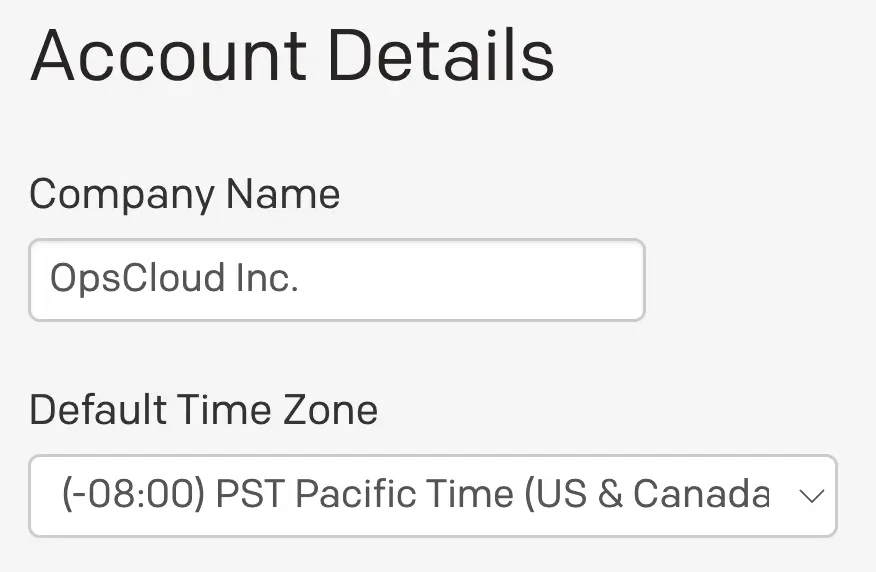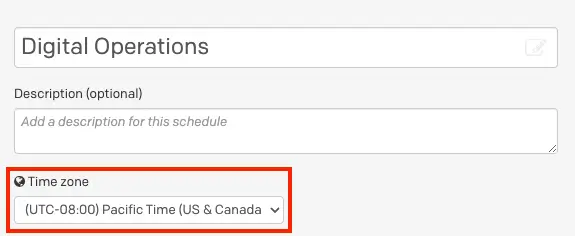Time Zone Settings
Administer the account-level, user-level and schedule-level time zones
Time zones help users contextualize the information that PagerDuty displays within incidents and schedules. When users are added to an account, their time zones will match the account-level time zone by default. Users can change their user-level time zone, if necessary. Regardless of the account-level time zone, on-call schedules are displayed in the user’s preferred time zone.
Change the Account-Level Time Zone
The Account Owner can change the account-level time zone in the web app:
- Navigate to User Icon Account Settings Account Settings tab.
- Under Account Details, select the Default Time Zone from the dropdown.
- Click Save Changes.

Default Time Zone set to "PST Pacific Time"
Change the User-Level Time Zone
Any user can adjust the time for their own account:
- Navigate to User Icon My Profile My Profile.
- To the right of Time zone, click .
- Select the desired Time zone from the dropdown.
- Click Save.
Change the Schedule-Level Time Zone
Required User Permissions
Users with the following roles can create, edit and delete on-call schedules:
- User
- Admin
- Manager base roles and team roles
- Manager team roles can only manage schedules associated with their team.
- Global Admin
- Account Owner
Note: Free plans are limited to one schedule.
When you create a new schedule, it will be set to the account-level time zone by default. You may, however, adjust the schedule’s time zone to differ from the account’s time zone. Before changing a schedule with users in multiple time zones, please read the section on how Daylight Saving Time may affect your schedules.
To change a schedule's time zone:
- Navigate to People Schedules click next to your desired schedule Edit.
- In the Time zone dropdown, select your preferred time zone.
- Click Save Schedule.

Schedule Time zone set to "Pacific Time"
Daylight Saving Time
If your account has users in different time zones, please consider the following with respect to how Daylight Saving Time (DST) may impact your schedules:
- A schedule will default to the account-level time zone. You can, however, change the schedule's time zone if you do not wish for it to match the account’s time zone.
- Users who are not in the same time zone as the schedule will still view it in their own time zone. For example, if a schedule is configured in US Eastern (EST) and it is 9:00 a.m., but another user has their account set to US Pacific (PST), the user's view of the schedule will reflect 6:00 a.m.
- In the case of DST discrepancies between users’ and schedules’ time zones (e.g., the user’s time zone observes DST but the schedule’s does not, and vice versa), the above details still apply. Users in this situation should take note of the following and the potential impact to their schedules:
- Example 1: If a schedule is set to USA EST (observing DST) at 2:00 a.m., but user Jon has his account set to UTC (not observing DST) at 7:00 a.m., when DST begins in the schedule's time zone, his view of his schedule will advance to 8:00 a.m., but his clock will remain at 7:00 a.m.
- Example 2: If a schedule is set to UTC (not observing DST) at 7:00 a.m. and user Emily’s account is set to US EST at 2:00 a.m., when DST begins in Emily’s time zone, her clock will advance to 3:00 a.m., but her view of her schedule will remain at 2:00 a.m.
Best Practice
When creating schedules with users in multiple time zones, we recommend taking note of the schedule’s time zone and communicating it to any users who may be affected by the observance/non-observance of DST.
Exceptions
Most times in the PagerDuty web app are displayed in the logged-in user’s time zone. A possible exception is Insights reports, which will give times in the account's time zone if a user has not configured their own time zone.
Additionally, any time-related information gathered from the REST API, such as incident trigger times, are displayed in UTC.
Updated about 2 months ago
